Discover 35 hidden attractions, cool sights, and unusual things to do in Saint Petersburg (Russia). Don't miss out on these must-see attractions: Peterhof Palace, Winter Palace, and Hermitage Museum. Also, be sure to include Saint Isaac's Cathedral in your itinerary.
Below, you can find the list of the most amazing places you should visit in Saint Petersburg (City of St. Petersburg).
Table of Contents
Peterhof Palace

Also known as: Петергоф
Museum in Saint Petersburg, Russia. The Peterhof Palace, is a series of palaces and gardens located in Petergof, Saint Petersburg, Russia, commissioned by Peter the Great as a direct response to the Palace of Versailles by Louis XIV of France. Originally intending it in 1709 for country habitation, Peter the Great sought to expand the property as a result of his visit to the French royal court in 1717, inspiring the nickname of "The Russian Versailles". The architect between 1714 and 1728 was Domenico Trezzini, and the style he employed became the foundation for the Petrine Baroque style favored throughout Saint Petersburg. Also in 1714, Jean-Baptiste Alexandre Le Blond, likely chosen due to his previous collaborations with Versailles landscaper André Le Nôtre, designed the gardens. Francesco Bartolomeo Rastrelli completed an expansion from 1747 to 1756 for Elizabeth of Russia. The palace-ensemble along with the city center is recognized as a UNESCO World Heritage Site.[1]
Address: Razvodnaya Ulitsa, 198510 Petergof
Winter Palace
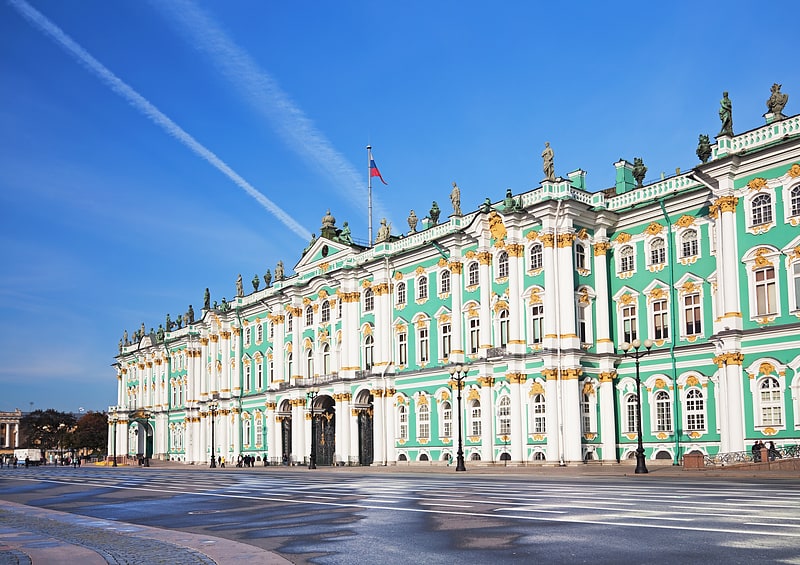
Also known as: Зимний дворец
Former residence of Russian emperors. The Winter Palace is a palace in Saint Petersburg that served as the official residence of the Russian Emperor from 1732 to 1917. The palace and its precincts now house the Hermitage Museum. Situated between Palace Embankment and Palace Square, adjacent to the site of Peter the Great's original Winter Palace, the present and fourth Winter Palace was built and altered almost continuously between the late 1730s and 1837, when it was severely damaged by fire and immediately rebuilt. The storming of the palace in 1917, as depicted in Soviet art and in Sergei Eisenstein's 1928 film October, became an iconic symbol of the Russian Revolution.
The emperors constructed their palaces on a monumental scale that aimed to reflect the might and power of Imperial Russia. From the palace, the tsars ruled over 22,800,000 square kilometers (8,800,000 sq mi) (almost 1/6 of the Earth's landmass) and 125 million subjects by the end of the 19th century. Several architects participated in designing the Winter Palace—most notably the Italian Bartolomeo Rastrelli (1700–1771)—in what became known as the Elizabethan Baroque style. The green-and-white palace has the overall shape of an elongated rectangle, and its principal façade is 215 metres (705 ft) long and 30 m (98 ft) high. The Winter Palace has been calculated to contain 1,886 doors, 1,945 windows, 1,500 rooms and 117 staircases. Following a serious fire, the palace's rebuilding of 1837 left the exterior unchanged, but large parts of the interior were redesigned in a variety of tastes and styles, leading the palace to be described as a "19th-century palace inspired by a model in Rococo style".
In 1905 the Bloody Sunday massacre occurred when demonstrators marched toward the Winter Palace, but by this time the Imperial Family had chosen to live in the more secure and secluded Alexander Palace at Tsarskoe Selo, and returned to the Winter Palace only for formal and state occasions. Following the February Revolution of 1917, the palace operated for a short time as the seat of the Russian Provisional Government, ultimately led by Alexander Kerensky. Later that same year a detachment of Red Guard soldiers and sailors stormed the palace—a defining moment in the birth of the Soviet state.[2]
Address: Palace Embankment, 32, 190000 Sankt-Peterburg (Центральный район)
Hermitage Museum

Also known as: Эрмитаж
Art and culture museum founded in 1764. The State Hermitage Museum is a museum of art and culture in Saint Petersburg, Russia. It is the largest art museum in the world by gallery space. It was founded in 1764 when Empress Catherine the Great acquired an impressive collection of paintings from the Berlin merchant Johann Ernst Gotzkowsky. The museum celebrates the anniversary of its founding each year on 7 December, Saint Catherine's Day. It has been open to the public since 1852. In 2021 it ranked 6th in the List of most visited art museums in the world, with 1,649,443 visitors.
Its collections, of which only a small part is on permanent display, comprise over three million items. The collections occupy a large complex of six historic buildings along Palace Embankment, including the Winter Palace, a former residence of Russian emperors. Apart from them, the Menshikov Palace, Museum of Porcelain, Storage Facility at Staraya Derevnya, and the eastern wing of the General Staff Building are also part of the museum. The museum has several exhibition centers abroad. The Hermitage is a federal state property. Since July 1992, the director of the museum has been Mikhail Piotrovsky.
Of the six buildings in the main museum complex, five—namely the Winter Palace, Small Hermitage, Old Hermitage, New Hermitage, and Hermitage Theatre—are all open to the public. The entrance ticket for foreign tourists costs more than the fee paid by citizens of Russia and Belarus. However, entrance is free of charge the third Thursday of every month for all visitors, and free daily for students and children. The museum is closed on Mondays. The entrance for individual visitors is located in the Winter Palace, accessible from the Courtyard.[3]
Address: Palace Square, 2, 190000 Sankt-Peterburg (Центральный район)
Saint Isaac's Cathedral
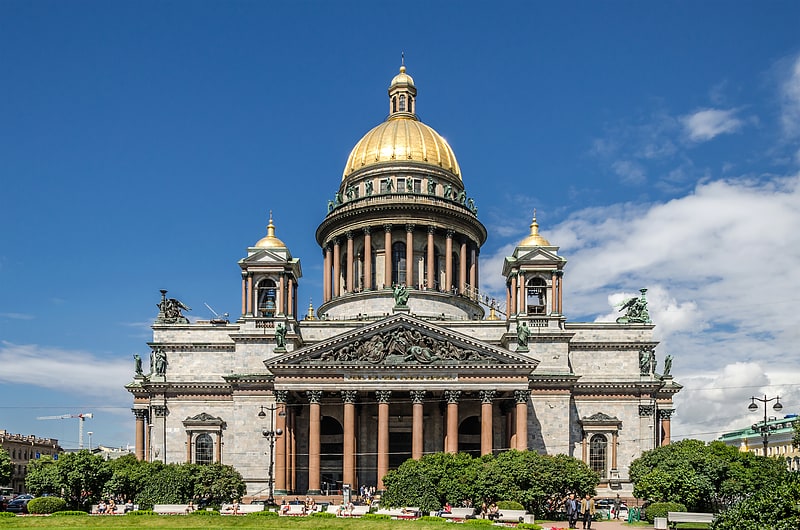
Also known as: Исаакиевский собор
Ornate religious edifice with gold dome. Saint Isaac's Cathedral or Isaakievskiy Sobor is a large architectural landmark cathedral that currently functions as a museum with occasional church services in Saint Petersburg, Russia. It is dedicated to Saint Isaac of Dalmatia, a patron saint of Peter the Great, who had been born on the feast day of that saint. It was originally built as a cathedral but was turned into a museum by the Soviet government in 1931 and has remained a museum ever since, with church services held in a side chapel since the 1990's. In 2017, the Governor of Saint Petersburg offered to transfer the cathedral back to the Russian Orthodox Church, but this was not accomplished due to the protests of St Petersburg citizens opposing the offer.[4]
Address: St Isaac's Square, 4, 190000 Sankt-Peterburg (Адмиралтейский район)
Pavlovsk Palace
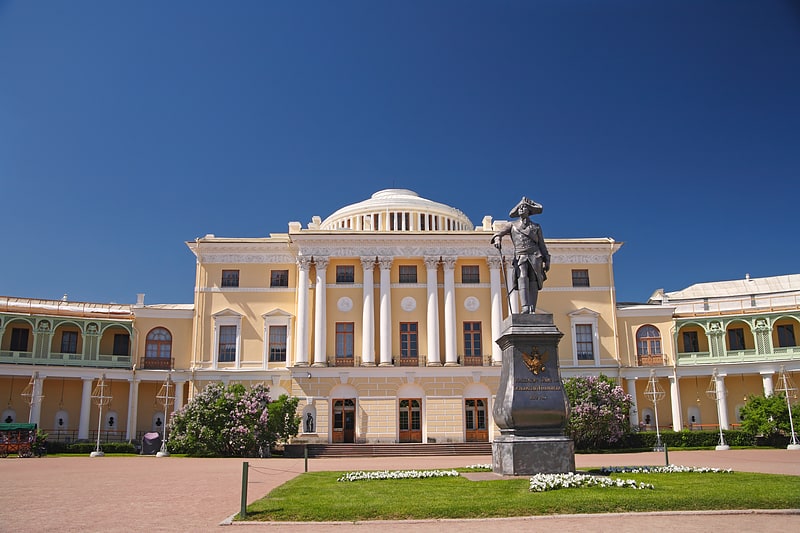
Also known as: Павловск
Museum in Saint Petersburg, Russia. Pavlovsk Palace is an 18th-century Russian Imperial residence built by the order of Catherine the Great for her son Grand Duke Paul, in Pavlovsk, within Saint Petersburg. After his death, it became the home of his widow, Maria Feodorovna. The palace and the large English garden surrounding it are now a Russian state museum and public park.[5]
Address: Sadovaya Ulitsa, 20, 196621 Pavlovsk
Church of the Savior on Blood

Also known as: Спас на Крови
1880s church with vibrant, lavish design. The Church of the Savior on Spilled Blood is a Russian Orthodox church in Saint Petersburg, Russia which currently functions as a secular museum and church at the same time. The structure was constructed between 1883 and 1907. It is one of Saint Petersburg's major attractions.
The church was erected on the site where political nihilists assassinated Emperor Alexander II in March 1881. The church was funded by the Romanov imperial family in honor of Alexander II, and the suffix "on Blood" refers to his assassination.[6]
Address: наб. канала Грибоедова, 2а, 191011 Санкт-Петербург (Центральный район)
Peter and Paul Fortress
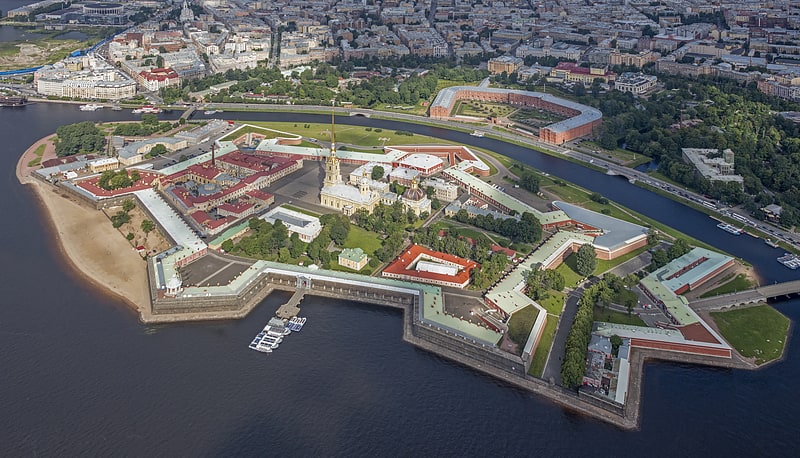
Also known as: Петропавловская крепость
Original city site founded in 1703. The Peter and Paul Fortress is the original citadel of St. Petersburg, Russia, founded by Peter the Great in 1703 and built to Domenico Trezzini's designs from 1706 to 1740 as a star fortress. Between the first half of 1700s and early 1920s it served as a prison for political criminals. It has been a museum since 1924.
Today it has been adapted as the central and most important part of the State Museum of Saint Petersburg History. The museum has gradually become virtually the sole owner of the fortress building, except the structure occupied by the Saint Petersburg Mint (Monetniy Dvor).[7]
Address: Заячий о., 197046 Санкт-Петербург (Петроградский район)
Strelna
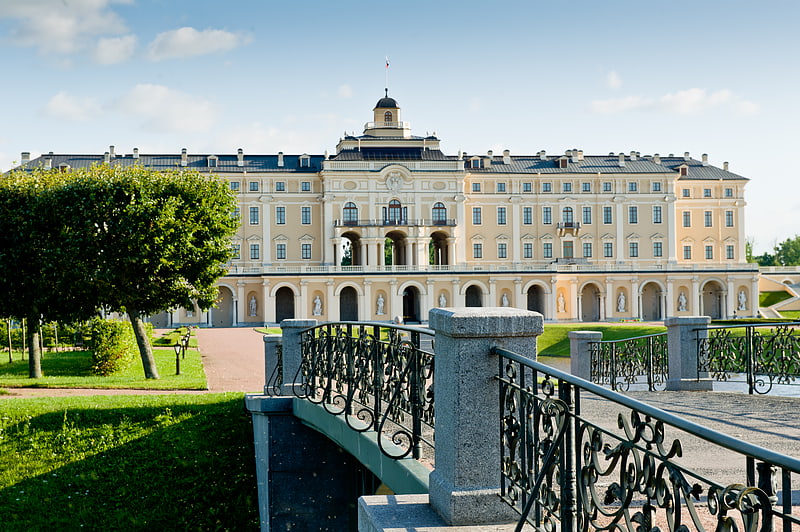
Also known as: Стрельна
Spa resort in Russia. Strelna is a municipal settlement in Petrodvortsovy District of the federal city of Saint Petersburg, Russia, about halfway between Saint Petersburg proper and Petergof, and overlooking the shore of the Gulf of Finland. Population: 12,452 ; 12,751 .[8]
Address: Beryozovaya Alley, 3, 198515 Strelna
Russian Museum
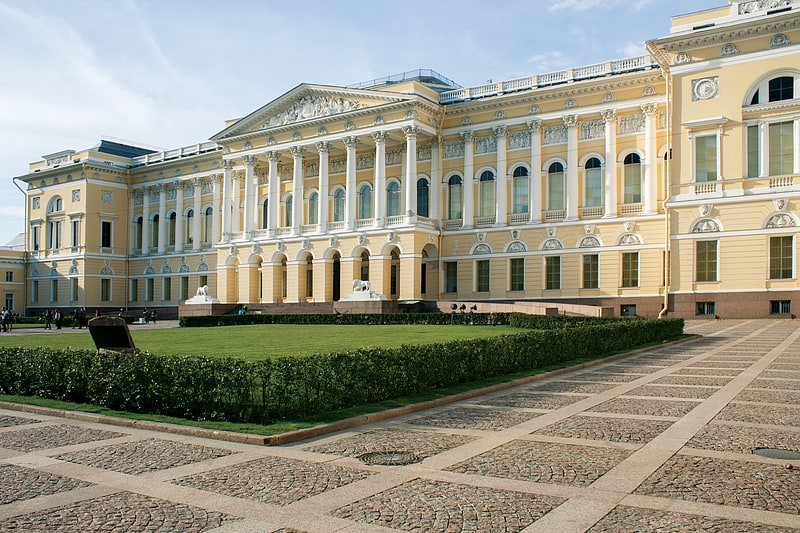
Also known as: Государственный Русский музей
Museum in Saint Petersburg, Russia. The State Russian Museum, formerly the Russian Museum of His Imperial Majesty Alexander III, on Arts Square in Saint Petersburg, is the world's largest depository of Russian fine art. It is also one of the largest art museums in the world with total area over 30 hectares. In 2021 it attracted 2,260,231 visitors, ranking second on list of most-visited art museums in the world.[9]
Address: Inzhenernaya St, 4, 191186 Sankt-Peterburg (Центральный район)
Zoological Museum
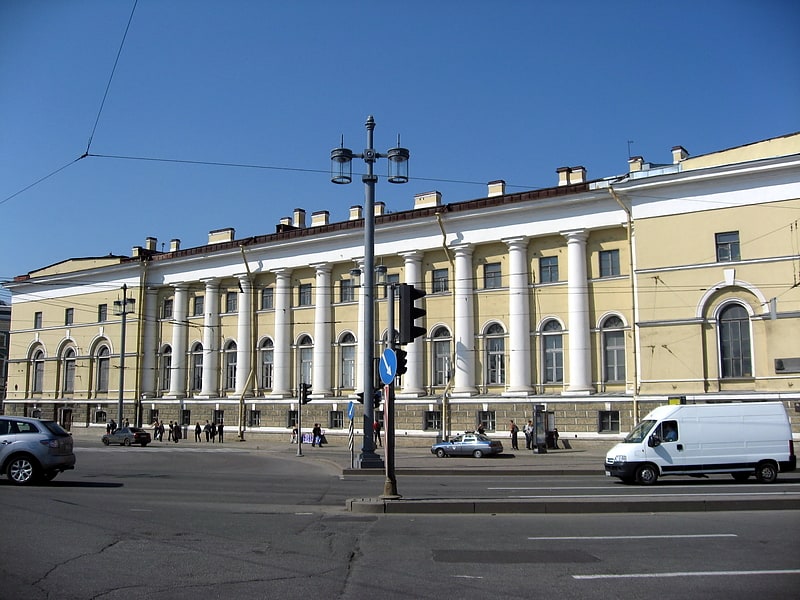
Also known as: Зоологический музей Зоологического института РАН
Displays of animal species and skeletons. The Zoological Museum of the Zoological Institute of the Russian Academy of Sciences is a Russian museum devoted to zoology. It is located in Saint Petersburg, on Universitetskaya Embankment. It is one of the ten largest nature history museums in the world.
Peter the Great's Kunstkamera collections included zoological specimens. In 1724, the museum became a part of the Russian Academy of Sciences. A printed catalogue of the contents was published in 1742. It listed the zoology, botany, geology and anthropology specimens and contained an album of etchings of the building and plan of some of its parts.
In 1766, Peter Simon Pallas, a member of the Russian Academy of Sciences, was appointed curator of Zoology. In 1832, the zoological collection was split from the Kunstkamera and, in 1896, moved nearby to its present location in the former southern warehouse of the Saint Petersburg bourse (constructed in 1826-1832). In 1931, the Zoological Institute was established within the Academy of Sciences, which included the museum.
In the front hall of the museum is a monument to Karl Ernst von Baer by the entrance, as well as skeletons of cetaceans, including the enormous 27-metre-long (89 ft) blue whale, and mounted pinnipeds. In the gallery above the front hall, the entomological collection is displayed. The second and third halls form a long passage with systematic collections and dioramas dating back to the early 20th century. The second hall hosts the collection of fishes, amphibians, reptiles, birds and invertebrates, mounted or preserved in formalin, and their skeletons or shells. The collection of mammals, including woolly mammoths, is displayed in the third hall.[10]
Address: University Embankment, 1, 199034 Sankt-Peterburg (Василеостровский район)
Alexander Column
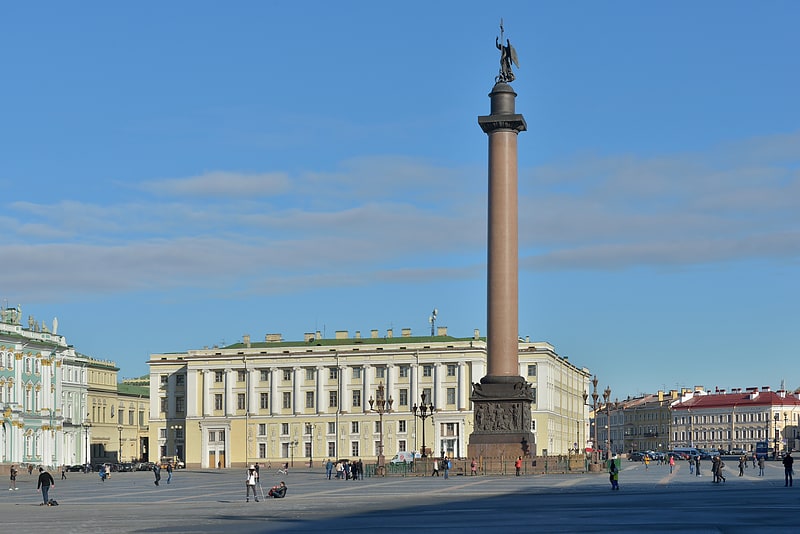
Also known as: Александровская колонна
Massive columnar war-victory memorial. The Alexander Column also known as Alexandrian Column, is the focal point of Palace Square in Saint Petersburg, Russia. The monument was raised after the Russian victory in the war with Napoleon's France. The column is named for Emperor Alexander I of Russia, who reigned from 1801–25.[11]
Address: Palace Square, 198324 Sankt-Peterburg (Центральный район)
Pulkovo Observatory
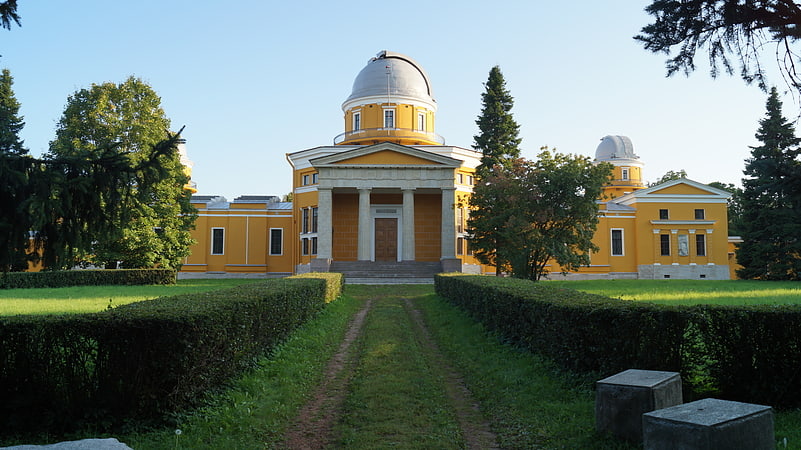
Also known as: Пулковская обсерватория
Astronomical observatory. The Pulkovo Astronomical Observatory, officially named The Central Astronomical Observatory of the Russian Academy of Sciences at Pulkovo, is the principal astronomical observatory of the Russian Academy of Sciences. It is located 19 km south of Saint Petersburg on Pulkovo Heights 75 metres above sea level. It is part of the UNESCO World Heritage Site Historic Centre of Saint Petersburg and Related Groups of Monuments. It was formerly known as the Imperial Observatory at Pulkowo.[12]
Address: 65 к1 Пулковское шоссе, Saint Petersburg (Московский район)
Rostral Columns

Also known as: Стрелка Васильевского острова
Historical landmark in Saint Petersburg, Russia. The Old Saint Petersburg Stock Exchange and Rostral Columns, located in Saint Petersburg in the Russian Federation, are significant examples of Greek Revival architecture. Designed by French architect Thomas de Thomon, and inspired by the Greek Temple of Hera at Paestum, the stock exchange was constructed between 1805 and 1810. The rostral columns erected on either side of the Stock Exchange were completed in 1811. The Old Saint Petersburg Stock Exchange is located at Birzhevaya Ploschad 4.[13]
Address: Birzhevaya Ploshchad', 199034 Sankt-Peterburg (Василеостровский район)
Stroganov Palace
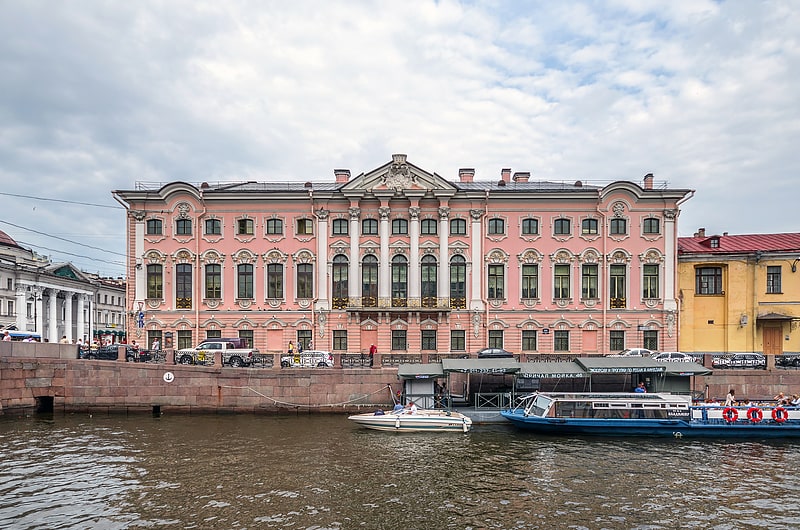
Also known as: Строгановский дворец
Pink palace, part of the Russian Museum. The Stroganov Palace is a Late Baroque palace at the intersection of the Moika River and Nevsky Prospect in St. Petersburg, Russia. The palace was built to Bartolomeo Rastrelli's designs for Baron Sergei Grigoriyevich Stroganov in 1753–1754. The interiors were remodeled by Andrei Voronikhin at the turn of the 19th century.[14]
Address: Nevsky avenue, 17, 191186 Sankt-Peterburg (Центральный район)
Fabergé Museum
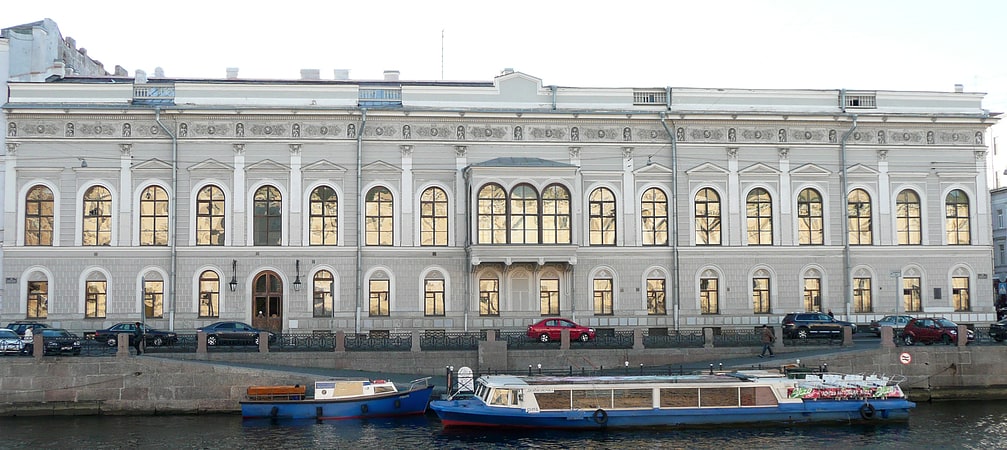
Also known as: Музей Фаберже в Санкт-Петербурге
Museum in Saint Petersburg, Russia. The Fabergé Museum in Saint Petersburg is a privately owned museum in Saint Petersburg, Russia. It was established by Viktor Vekselberg and his Link of Times foundation in order to repatriate lost cultural valuables to Russia. The museum is located in central Saint Petersburg at the Naryshkin-Shuvalov Palace on the Fontanka River. The museum's collection contains more than 4,000 works of decorative applied and fine arts, including gold and silver items, paintings, porcelain and bronze. A highlight of the museum's collection is the group of nine Imperial Easter eggs created by Fabergé for the last two Russian Tsars.[15]
Address: Fontanka river embankment, 21, 191023 Sankt-Peterburg (Центральный район)
Suvorov Monument

The Suvorov Monument is a bronze sculpture of Generalissimo Alexander Suvorov located in Saint Petersburg. It is at the centre of Suvorov Square, opposite the Field of Mars and the Trinity Bridge, and between the Marble Palace and the Saltykov Mansion.
Commissioned in 1799 by Emperor Paul I to commemorate Suvorov's Italian expedition that year, the execution was entrusted to sculptor Mikhail Kozlovsky. His design was approved in early 1800, and depicted Suvorov in the allegorical guise of the god Mars. The sculpture was cast in bronze, but neither Paul nor Suvorov lived to see its unveiling, which took place in May 1801. The monument marked a number of firsts, it was the first monument in Russia to someone other than a member of the Imperial family, and the first time that a monument had been ordered during the subject's lifetime. It was also first major monument created entirely by Russian craftsmen.
The monument was originally planned to be located in Gatchina, though the site was changed to the Tsaritsyn Meadows, later the Field of Mars. It was unveiled in the presence of Emperor Alexander I, many of his generals, and Suvorov's son Arkadi. The monument was moved to its present location in 1818 as part of a general reconstruction of the area by architect Carlo Rossi. It now stands at the centre of Suvorov Square. Its pedestal was replaced in the 1830s, and it survived the siege of Leningrad undamaged.[16]
Ice Palace
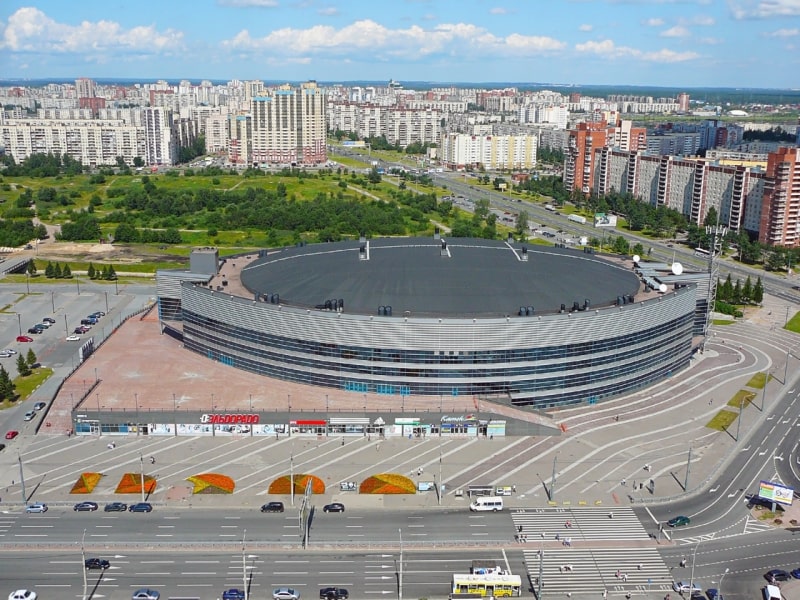
Also known as: Ледовый дворец
Arena in Saint Petersburg, Russia. The Ice Palace is an arena in Saint Petersburg, Russia. It was built for the 2000 IIHF World Championship and opened in 2000. It holds 12,300 people.
The Ice Palace is primarily used for ice hockey and is the home arena for SKA Saint Petersburg. It hosted the IIHF European Champions Cup in 2005, 2006, 2007 and 2008. It is also used for concerts, exhibitions and as a skating rink.[17]
Address: просп. Пятилеток, 1, 193318 Санкт-Петербург (Невский район)
Kronstadt Naval Cathedral
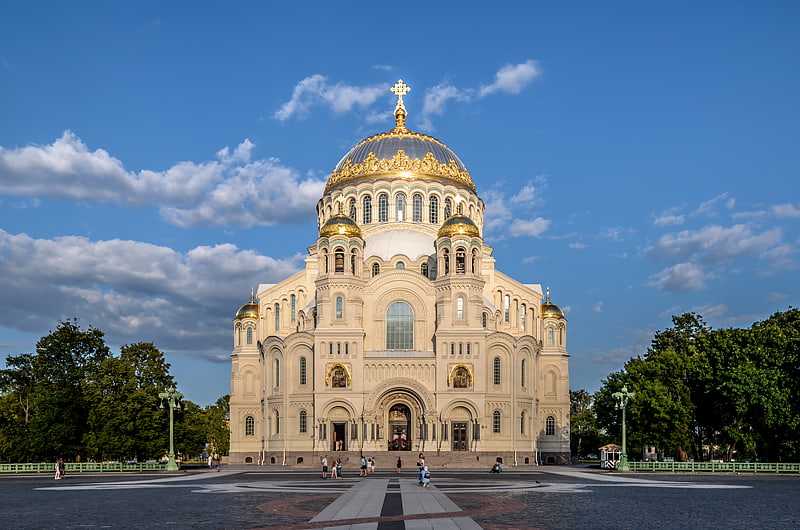
Also known as: Морской Никольский собор
Navy-affiliated Russian Orthodox church. The Naval cathedral of Saint Nicholas in Kronstadt is a Russian Orthodox cathedral built in 1903–1913 as the main church of the Russian Navy and dedicated to all fallen seamen. The cathedral was closed in 1929, was converted to a cinema, a House of Officers and a museum of the Navy.
The Russian Orthodox Church reinstalled the cross on the main dome in 2002 and (for the first time since 1929) served the Divine Liturgy in the cathedral in 2005. In 2013, the Patriarch of Russia, with Prime Minister Dmitriy Medvedev and his spouse attending, conducted the ceremony of grand reconsecration in the now fully restored cathedral.[18]
Address: Yakornaya sq, 1, 197762 Kronshtadt
Our-Lady-of-Kazan Cathedral
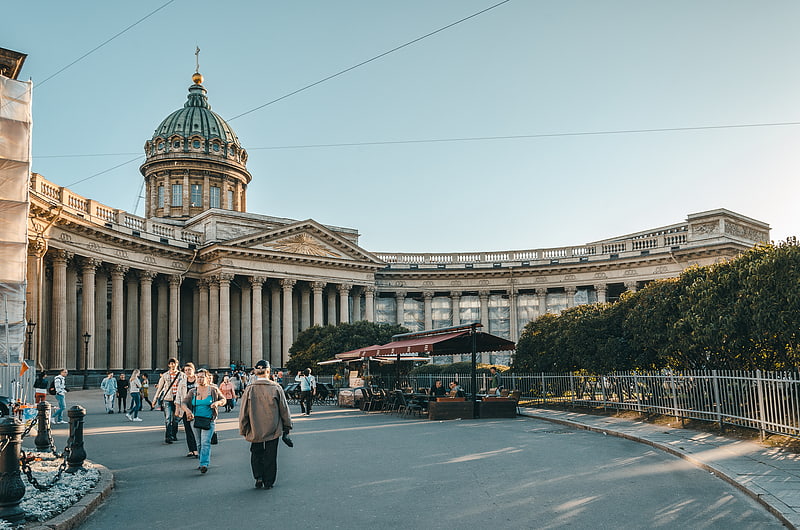
Also known as: Казанский собор
Colonnaded Russian Orthodox cathedral. Kazan Cathedral or Kazanskiy Kafedralniy Sobor, also known as the Cathedral of Our Lady of Kazan, is a cathedral of the Russian Orthodox Church on the Nevsky Prospekt in Saint Petersburg. It is dedicated to Our Lady of Kazan, one of the most venerated icons in Russia.[19]
Address: Казанская пл., 2, 191186 Санкт-Петербург (Центральный район)
General Staff Building

Also known as: Здание Главного штаба
Museum in Saint Petersburg, Russia. The General Staff Building is an edifice with a 580 m long bow-shaped facade, situated on Palace Square in Saint Petersburg, Russia, in front of the Winter Palace.
The monumental Neoclassical building was designed by Carlo Rossi in the Empire style and built in 1819–1829. It consists of two wings, which are separated by a tripartite triumphal arch adorned by sculptors Stepan Pimenov and Vasily Demuth-Malinovsky and commemorating the Russian victory over Napoleonic France in the Patriotic War of 1812. The arch links Palace Square through Bolshaya Morskaya Street to Nevsky Prospekt.
Until the capital was transferred to Moscow in 1918, the building served as the headquarters of the General Staff (western wing), Foreign Ministry and Finance Ministry (eastern wing).
The western wing now hosts the headquarters of the Western Military District. The eastern wing was given to the Hermitage Museum in 1993 and was extensively remodeled inside.[20]
Address: Дворцовая пл., 6/8, 191186 Санкт-Петербург (Центральный район)
Smolny Convent
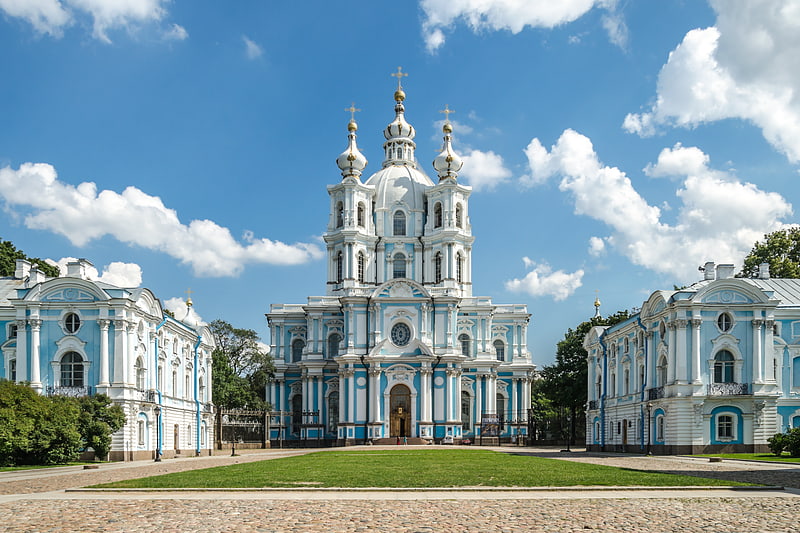
Also known as: Смольный монастырь
Building in Saint Petersburg. Smolny Convent or Smolny Convent of the Resurrection, located on Ploschad Rastrelli, on the left bank of the River Neva in Saint Petersburg, Russia, consists of a cathedral and a complex of buildings surrounding it, originally planned as a convent.[21]
Address: 1 площадь Растрелли, Saint Petersburg (Центральный район)
Vladimir Palace
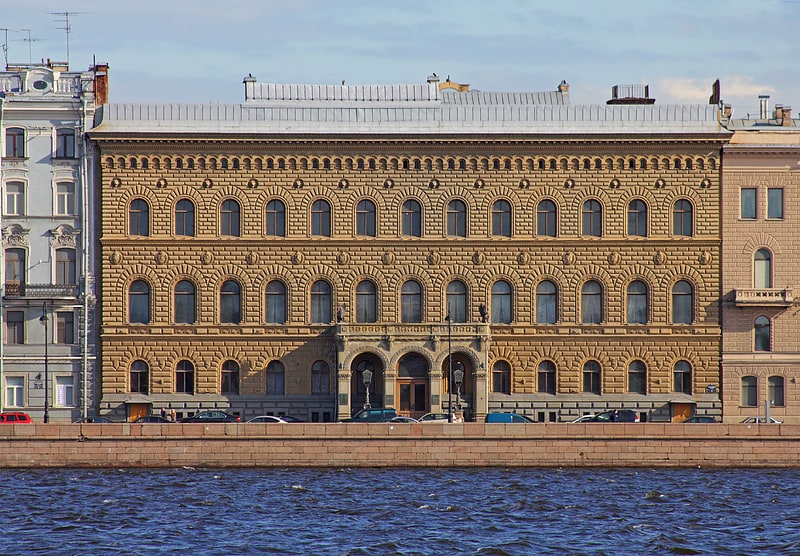
Also known as: Владимирский дворец
Palace. The Vladimir Palace was the last imperial palace to be constructed in Saint Petersburg, Russia. It was designed by a team of architects for Alexander II's son, Grand Duke Vladimir Alexandrovich of Russia. Construction work lasted from 1867 to 1872.
Like the Winter Palace and the Marble Palace, the Vladimir Palace fronts Palace Embankment; water frontage on the Neva was extremely prized by the Russian aristocracy. The façade, richly ornamented with stucco rustication, was patterned after Leon Battista Alberti's palazzi in Florence. The main porch is built of Bremen sandstone and adorned with griffins, coats-of-arms, and cast-iron lanterns. Other details are cast in portland cement.
The palace and its outbuildings contain some 360 rooms, all decorated in disparate historic styles: Neo-Renaissance, Gothic Revival, Russian Revival, Rococo, Byzantine style, Louis XIV, various oriental styles, and so on. This interior ornamentation, further augmented by Maximilian Messmacher in 1880–1892, is considered a major monument to the 19th-century passion for historicism.
After the October Revolution, the palace became the home of the first House of Scientists, and as a consequence its interior has been preserved to a greater extent than other Romanov family residences. Much attractive tiling, and many internal architectural details have been retained. Also preserved has been much of Vladimir's collection of late 19th-century porcelain, most of it manufactured in the Imperial Porcelain Factory, and painted or decorated by its leading artists. The collection has been extended to include interesting porcelain from the early Soviet period, including figures of Chaliapin and Nijinsky, as well as vases and dinner services inspired by constructivism.[22]
Address: Palace Embankment, 26, 191186 Sankt-Peterburg (Центральный район)
Marble Palace
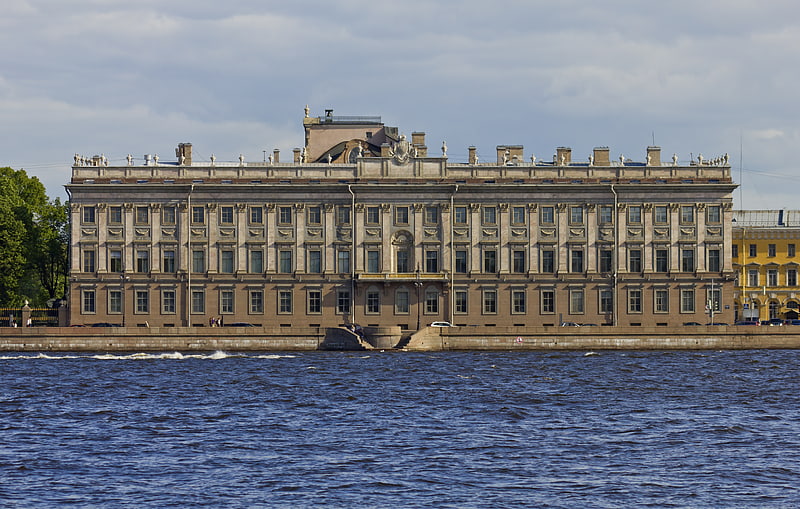
Also known as: Мраморный дворец
Museum of Russian art and sculpture. Marble Palace is one of the first Neoclassical palaces in Saint Petersburg, Russia. It is situated between the Field of Mars and Palace Quay, slightly to the east from New Michael Palace.[23]
Address: Millionnaya St., 5/11, 191186 Saint Petersburg (Центральный район)
Winter Palace
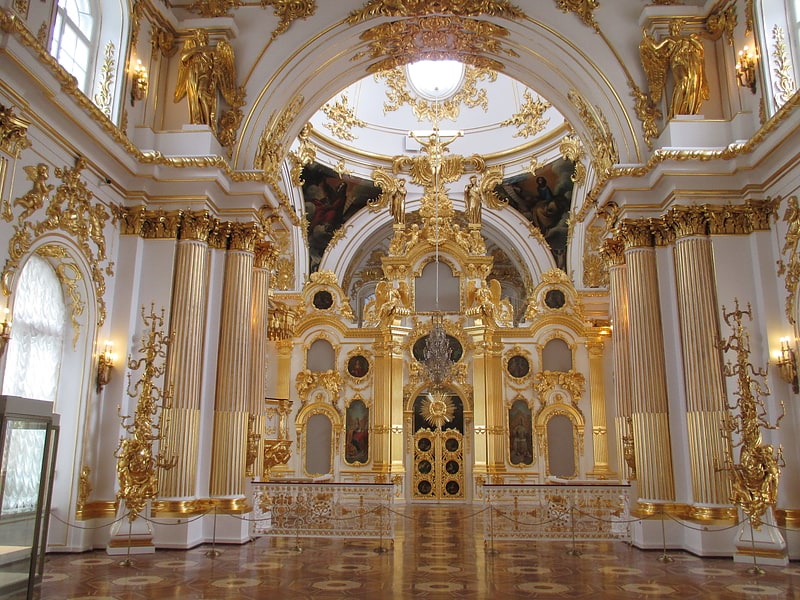
Also known as: Большая церковь Зимнего дворца
The Grand Church of the Winter Palace in Saint Petersburg, sometimes referred to as the Winter Palace's cathedral, was consecrated in 1763. It is located on the piano nobile in the eastern wing of the Winter Palace, and is the larger, and principal, of two churches within the Palace. A smaller, more private church was constructed in 1768, near the private apartment in the northwest part of the wing. The Grand Church was designed by Francesco Rastrelli, and has been described as "one of the most splendid rooms" in the Palace. Today, the church is an unconsecrated exhibition hall of the State Hermitage Museum.[24]
New Michael Palace

Also known as: Ново-Михайловский дворец
Palace in Saint Petersburg, Russia. The New Michael Palace was the third Saint Petersburg palace designed by Andrei Stackenschneider for Nicholas I's children. It was built between 1857 and 1862 on the Palace Embankment, between the Hermitage Museum buildings and the Marble Palace.
The palace was commissioned by Grand Duke Michael Nikolaevich of Russia on the occasion of his wedding to Cecilie of Baden. The design is a Revivalist medley of quotations from the Renaissance, Baroque, and the Louis XVI styles. The Rococo interiors are ornate yet airy. The statuary is by David Jensen. Some of the paintings are by Michael Zichy.
A residential wing of the palace fronts on Millionnaya Street. Its decoration is not as riotous, but the distinctive curvilinear facade reflects the Italianate taste of the 1740s. The wing has its origin in the Baroque palace of Chancellor Tcherkassky whose design has been attributed to Pyotr Yeropkin.
After the Russian Revolution the palace housed a branch of the Communist Academy. Then in 1949 it was occupied by the Institute of Oriental Studies, later the Leningrad branch of the IOS, and it is currently occupied by its successor, the Institute of Oriental Manuscripts.
The building stands well preserved thanks to a major restoration effort of 2005-2009. The former stables were recently reconstructed with funds provided by Qaboos bin Said al Said in order to house some 1,000,000 Oriental books and manuscripts from the institute's collection.[25]
Winter Canal
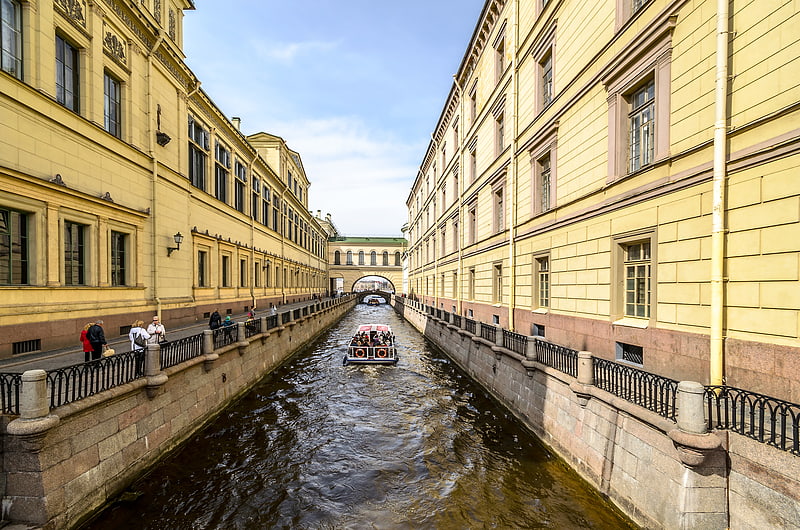
Canal in Russia. Winter Canal is a canal in Saint Petersburg, Russia, connecting Bolshaya Neva with Moika River in the vicinity of Winter Palace.
The canal was dug in 1718–19. It is only 228 metres (748 ft) long, which makes it one of the shortest canals in the city. The width is about 20 metres (66 ft).
The granite embankment was built in 1782–84, and railings designed by sculptor I.F.Dunker were added at the same time. The special picturesqueness to the canal is added by the arch connecting Old Hermitage and Hermitage Theater, built by architect Yury Felten next to the Hermitage Bridge.[26]
Moika Palace

Also known as: Дворец Юсуповых на Мойке
Grand palace museum with ornate decor. The Palace of the Yusupovs on the Moika, known as the Moika Palace or Yusupov Palace, is a former residence of the Russian noble House of Yusupov in St. Petersburg, Russia, now a museum. The building was the site of Grigori Rasputin's murder in the early morning of December 17, 1916. Sometimes called the Moika Palace to tell it apart from other palaces of the same family in Saint Petersburg, though it is not the only palace on this river in the city.[27]
Address: наб. р. Мойки, 94, 190000 Санкт-Петербург (Адмиралтейский район)
Kunstkamera

Also known as: Кунсткамера
Anthropological and ethnographic museum. The Kunstkamera is the first museum in Russia. Established by Peter the Great and completed in 1727, the Kunstkammer Building hosts the Peter the Great Museum of Anthropology and Ethnography, with a collection of almost 2,000,000 items. It is located on the Universitetskaya Embankment in Saint Petersburg, facing the Winter Palace.[28]
Address: Университетская наб., 3, 199034 Санкт-Петербург (Василеостровский район)
Central Naval Museum

Also known as: Центральный военно-морской музей
Museum in Saint Petersburg, Russia. Central Naval Museum is a naval museum in St Petersburg, Russia. It is one of the first museums in Russia and one of the world’s largest naval museums, with a large collection of artefacts, models and paintings reflecting the development of Russian naval traditions and the history of the Russian Navy. The museum’s permanent display includes such relics as the Botik of Peter the Great, Catherine II’s marine throne, trophies captured in sea battles, and the personal belongings of prominent Russian and Soviet naval commanders. The collection includes paintings by Ivan Aivazovsky, Alexey Bogolyubov, Lev Lagorio and other marine artists, ship sculpture, navigational instruments, naval equipment and machinery from the 17th to 20th centuries and numerous models of ships. The main exposition consists of nineteen halls. There is a complex of six museum halls for exhibitions.[29]
Address: Birzhevaya Square (Биржевая пл.), 4, Saint Petersburg (Василеостровский район)
Monplaisir Palace
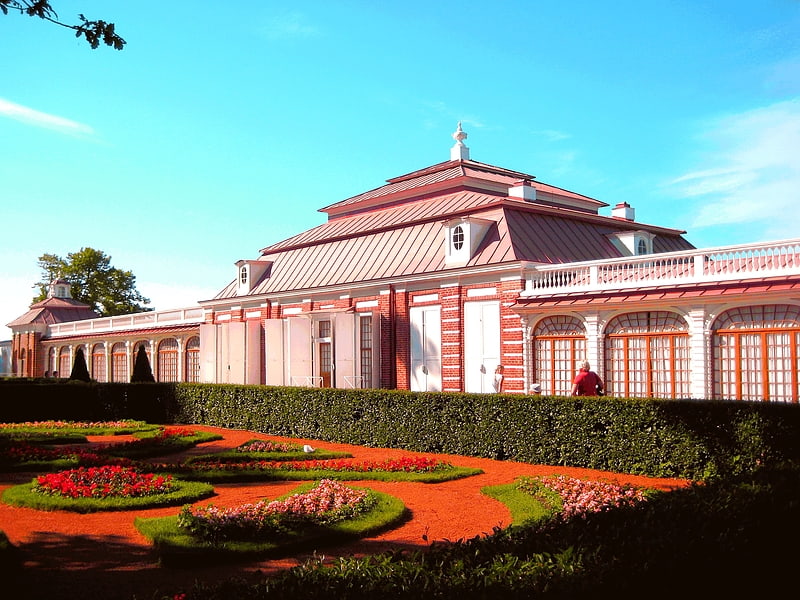
Also known as: Монплезир
Palace in Russia. The Monplaisir Palace is part of the Peterhof Palace Complex, Russia.[30]
Address: Nizhniy Park, 4, 198510 Peterhof
Zoo

Also known as: Ленинградский зоопарк
Zoo with polar bears, giraffes and monkeys. The Leningrad Zoo, sometimes called the Saint Petersburg Zoo or Sankt-Peterburgskiy Zoopark, in Saint Petersburg, Russia, is located in Alexander Park in the Petrogradskaya Storona. It was founded by Sofia Gerhardt and Julius Gerhardt in 1865. It has about 2,000 animals from 410 species, including polar bears. It is one of the oldest zoos in Russia, as well as the most northernly.
The zoo was renamed from "Zoological Garden" to "Leningrad Zoo" in 1952. In 1991 the name was retained, even after the city resumed its former name of Saint Petersburg, in commemoration of the zoo workers' deed of saving the animals during the Leningrad Blockade.[31]
Address: Александровский парк, 1, 197198 Санкт-Петербург (Петроградский район)
Cabin of Peter the Great
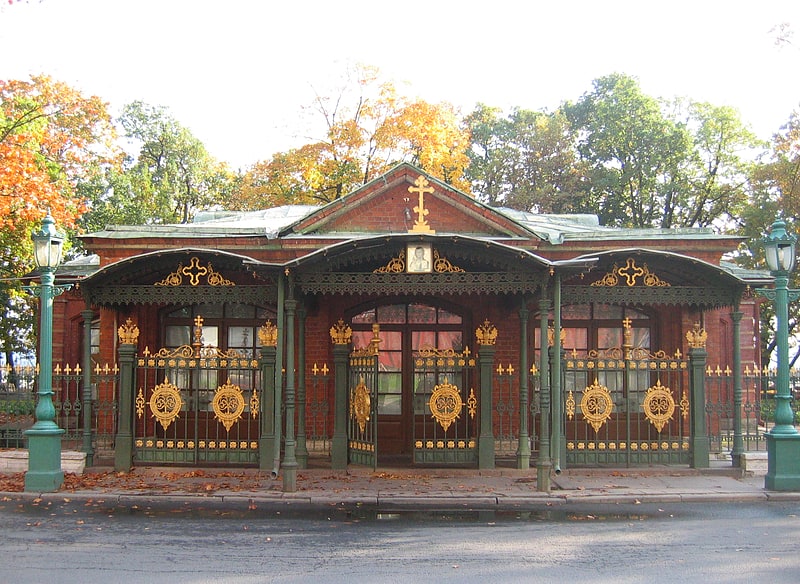
Also known as: Домик Петра I
Historical place museum in Saint Petersburg, Russia. The cabin of Peter the Great is a small wooden house which was the first St Petersburg "palace" of Tsar Peter the Great.
The log cabin was constructed in three days in May 1703, by soldiers of the Semyonovskiy Regiment. At that time, the new St. Petersburg was described as "a heap of villages linked together, like some plantation in the West Indies". The date of its construction is now considered to mark the foundation of the city.
The design is a combination of an izba, a traditional Russian countryside house typical of the 17th century, and the Tsar's beloved Dutch Baroque, later to evolve into the Petrine Baroque. Peter built similar domiki elsewhere in Russia - for example, in Voronezh, and Vologda. The wooden cabin in St. Petersburg covers only 60 square metres (650 sq ft) and contains three rooms - living room, bedroom, and study. It has large ornate windows and a high hipped roof of wooden tiles. Inside, the wooden walls were painted with red oil to resemble brick, and the rooms came to be known as the "red chambers" (krasnyie khoromtsy). There are no fires or chimneys, as it was intended to be used only in the warmer summer months. It was occupied by the Tsar between 1703 and 1708, while Peter supervised the construction of the new imperial city and the Peter and Paul Fortress.
The cabin was moved to its present location, 6 Petrovskaia Naberezhnaia, in 1711 from its original site on the north bank of the River Neva close to the present Winter Palace. Peter had it encased for its protection within a red brick pavilion in 1723, and ordered that it be preserved for posterity as a memorial to his modesty, and the creation of St. Petersburg ex nihilo. Catherine the Great ordered the shelter for the cabin to be renovated in 1784, and the protective brick pavilion was reconstructed by Nicholas I in the 1840s. Nicholas I also had the bedroom converted into a chapel dedicated to Christ the Redeemer, and iron railings were added in 1874.
Peter's domiki were used to mark significant dates, such as the bicentenary of Peter's birth in 1672. They became a centre of devotion to the tsar, the Russian Orthodox Church, and the Russian motherland (rodina). An image of the log cabin was included on the Peter the Great Fabergé egg, created in 1903 to celebrate the bicentenary of the founding of St. Petersburg. After the Russian Revolution, they became symbols of Russian heroic labour.
A prized national monument, the contents were removed, and the Cabin was boarded up and camouflaged during the Second World War. It was the first St. Petersburg museum to reopen in September 1944, after the end of the Siege of Leningrad. Personal and domestic objects owned and used by Peter are still displayed within, and a bust of Peter by Parmen Zabello stands outside. The cabin is open to the public as a branch of the Russian Museum.[32]
Address: Петровская наб., 6, 197046 Санкт-Петербург (Петроградский район)
Saint Michael's Castle

Also known as: Михайловский замок
Art exhibitions in 1790s royal residence. Saint Michael's Castle, also called the Mikhailovsky Castle or the Engineers' Castle, is a former royal residence in the historic centre of Saint Petersburg, Russia. Saint Michael's Castle was built as a residence for Emperor Paul I of Russia by architects Vincenzo Brenna and Vasily Bazhenov in 1797–1801. It was named for St Michael the Archangel, patron saint of the royal family. The castle looks different from each side, as the architects used motifs of various architectural styles such as French Classicism, Italian Renaissance and Gothic.
Saint Michael's Castle was built to the south of the Summer Garden and replaced the small wooden palace of Empress Elizabeth Petrovna. Afraid of intrigues and assassination plots, Emperor Paul I disliked the Winter Palace where he never felt safe. Due to his personal fascination with medieval knights and his constant fear of assassination, the new royal residence was built like a castle around an octagonal courtyard. The building with rounded corners was surrounded by the waters of the Moika River, the Fontanka River and two specially dug canals, transforming the castle area into an artificial island which could only be reached by drawbridges.
Construction began on 26 February, 1797 and the castle was solemnly consecrated on 8 November 1800, i.e. on St Michael's Day in the Eastern Orthodox calendar, though finishing work on the interior continued until March 1801. In 1800, the bronze equestrian Monument to Peter the Great was set up in front of the castle. This statue had been designed during Peter the Great's lifetime and later, with the casting being completed in 1747 by the architect Bartolomeo Rastrelli. By order of Paul I, the inscription "From Great Grandson to Great Grandfather" was made on the pedestal that is decorated with bas-reliefs depicting scenes of two Russian victories over Sweden during the Great Northern War.
Paul I was assassinated only 40 nights after he moved into his newly built castle. He was murdered on 12 March 1801, in his own bedroom, by a group of dismissed officers headed by General Bennigsen. The conspirators forced him to a table, and tried to compel him to sign his abdication. Paul offered some resistance, and one of the assassins struck him with a sword, and he was then strangled and trampled to death. He was succeeded by his son, Emperor Alexander I, who was actually in the palace at the time and was informed of his accession by General Nicholas Zubov, one of the assassins.
After Paul's death, the imperial family returned to the Winter Palace; Saint Michael's Castle was abandoned and in 1823 was given to the army's Main Engineering School. From then on, the building was known as the Engineers' Castle. Between 1838 and 1843, the Russian writer Fyodor Dostoyevsky studied as a cadet at the Main Engineering School.
In the early 1990s, Saint Michael's Castle became a branch of the Russian Museum and now houses its Portrait Gallery, featuring official portraits of the Russian Emperors and Empresses and various dignitaries and celebrities from the late 17th to the early 20th century.[33]
Address: Садовая ул., 2, 191011 Санкт-Петербург (Центральный район)
Military Historical Museum of Artillery
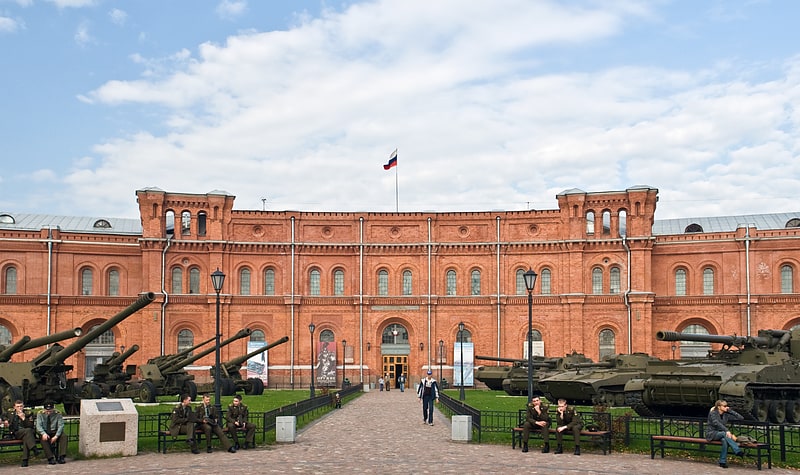
Also known as: Военно-исторический музей артиллерии, инженерных войск и войск связи
Historical museum on Russian military. The Military Historical Museum of Artillery, Engineers and Signal Corps, also known simply as the Artillery Museum, is a state-owned military museum in Saint Petersburg, Russia. Its collections – consisting of Russian military equipment, uniforms and decorations – are hosted in the Kronverk situated on the right bank of the Neva near Alexander Park. The museum is managed by the Russian Ministry of Defence.[34]
Address: Aleksandrovskiy Park, 7, 197046 Saint Petersburg (Петроградский район)
Fountain House
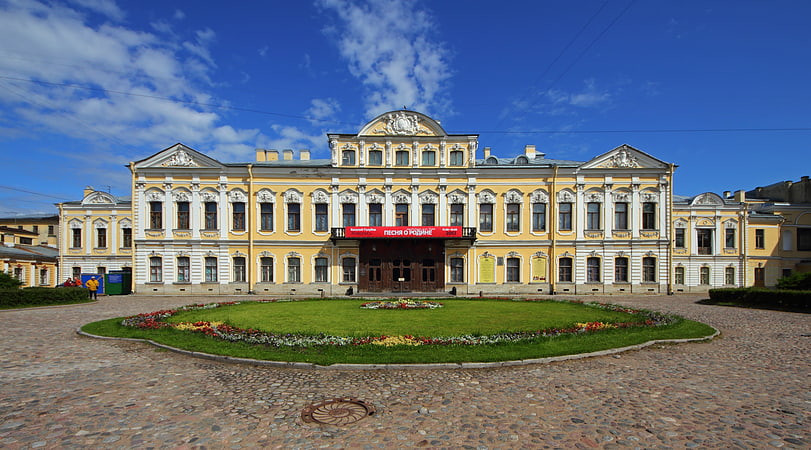
Palace in Saint Petersburg, Russia. The Fountain House is a palace in Russia built by the Sheremetev family, named after the nearby Fontanka river. Since its erection in 1712 the building was reconstructed several times by famous architects G. Dmitryev, Savva Chevakinsky, Fyodor Argunov, and Ivan Starov. It is also known as the Sheremetev Palace.[35]